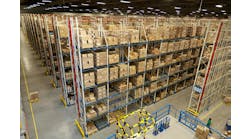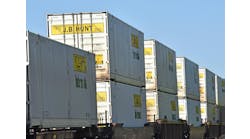Despite all the talk about homeland security and the apparent vulnerability of goods within the supply chain, there does not appear to be an across-the-board rush to increase security on packages. There are indications of heightened awareness and concern, particularly in the area of tracking parcels. Certainly, various parts of our government, and specific areas within our economy such as food supply, have a higher awareness of security issues than does the general population. Tracking and tracing material is critical for some economic segments.
One truth, proven in many surveys, is that people receiving packages — at home or at places of business — assign high value to getting the package intact and undamaged. Channels of distribution have changed. The new distribution system is tougher on single packages than it is on palletloads. Single-parcel shipments have soared with the increase in catalog and Web-based shopping.
Following a study by 3M in October 2000, Dick Sheehan, 3M senior package engineering specialist, said, “The typical packaging systems used by manufacturers may not be adequate to protect single parcels as they travel from manufacturer to a distribution center to a delivery service to the customer.”
Bill Armstrong, technical development manager, Sealed Air, says his company has recently been involved in a number of proprietary projects in which companies have used transport packaging material to address various security or protection concerns.
“We’ve seen companies use packaging material and technologies to attack issues such as fraud or major security problems,” says Armstrong.
If and when companies do turn to packaging for defense, they’ll find an industry ready to roll. Companies, like Sealed Air, have long been in the business of supporting banks and brokerage houses with special envelopes and other material. 3M has introduced a variety of security tapes and closure material.
For example, the Scotch Tamper Indicating Tape 3559 proves to the package receiver whether the package has been breached in transit. If an unauthorized person attempts to peel back the tape, a security “alert” message is revealed. The tape cannot be reapplied without the message showing. When the tape is pulled off, significant fiber tear may also be evident. If the tape is slit on the center seam, the tape’s diagonally banded printing pattern makes perfect realignment difficult.
Armstrong says protecting products in the future will not require some new innovation. It’s a matter of applying existing material and technologies. “There are still a lot of features that can be achieved with certain material in different forms,” he says. “People are looking for comprehensive solutions. Now, it’s a matter of devising them because these are not off-the-shelf situations.”
Armstrong says answers to security issues are found in team efforts, combining knowledge from a variety of industries and disciplines, rather than within a single industry or company.
Bill Gray, vice president of marketing for engineered products at Sealed Air, says he has not detected any dramatic change in behavior or sales patterns among the manufacturers and suppliers of packaging material as a result of heightened security.
What to watch for
One trend to watch in protective packaging and material protection, and it has a scope greater than homeland security, is the use of radio frequency identification (RFID) tagging. Tracking and tracing food products, in particular, is a major issue, and packaging companies are at the forefront in working with food manufacturers.
Armstrong says this move toward greater use of RFID in packaging is an evolutionary thing. “There’s been an ongoing effort within the food packaging industry,” says Armstrong, “to have accountability and tracking of individual packages. It’s certainly needed as we consolidate food processing back upstream to single suppliers.”
Seemingly disparate problems of security, rapid processing and delivery, efficient production management and supply, as well as requirements to track goods by lot numbers, all tie into packaging. Tracking goods by the palletload or individual pieces has been a challenge for 3M.
“Companies are having difficulty [complying] with customer requirements, security or government regulations,” says Mike Haldane, business manager, 3M Global Packaging Services.
A project, started about three years ago as a way to manage packaging information at 3M, has evolved into a commercial product with security and other benefits. 3M created what it terms an integrated packaging tool. It’s a Web-based information system, part of a suite of packaging-related services.
“With most companies supporting multiple databases and disparate enterprise resource planning systems,” says Haldane, “packaging has become a real struggle.”
From the user’s perspective, the integrated packaging tool brings together all the various pieces into one, manageable place. Haldane says it works in concert with the host company’s data as well as business and regulatory rules to maintain tight security and archive a full history of activity.
Programs such as the integrated packaging tool can become part of a larger program within the user company to track its products from point of manufacture to the end user, says Haldane.
Armstrong adds that one issue facing packaging professionals has been the change in distribution channels. “No longer do you have the one-size packaging material that fits all,” he says. “Now we have to be concerned with a package for the retail store, the home consumer and the club store environment. The product might be the same, it’s how it’s delivered that varies widely.”
Gray says another trend in the packaging world is that packaging managers are thinking more about systems than in the past. “With that has come a push from the customer side to make what delivers the packaging material simple and user friendly,” he says. Gray attributes this push to the fact that training is a chore for many companies. Companies would prefer to have systems that are easy to use and quick to learn.
“Companies might look for systems that are simpler to use, but you can’t lose sight of the fact that you still have to fit the type of packaging material to the need,” he says.
Armstrong adds that while the trend in packaging might be toward better protection, source reduction and other environmental concerns are still at the forefront of every packaging manager’s agenda.
The best advice experts give regarding material protection is that you look upstream. Review your manufacturing processes. You don’t want to have packaging problems develop when the product arrives at the distribution center. And you have to look downstream. You have to know where the product is headed once it leaves your building. It’s not out the door until it’s out the door. And once it is out the door, there’s nothing more you can do to ensure its survival.


